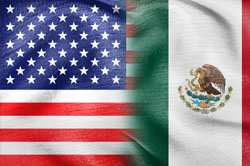The American Union
Monday, July 12, 2010

Fence or no fence, law or no law, Mexicans and Central Americans will keep crossing the border.
It breaks rules. It’s unfair to would-be immigrants from other parts of the world. It’s sometimes deadly.
But the American Union, in which Mexicans and Central Americans can work in the United States if they want it badly enough, is here, and no barrier – physical or legal – will do much to change it.
A 2000-mile long high-tech perimeter between San Diego and Brownsville, will – at a cost of several billion dollars - keep out some migrants.
But for a few pesos worth of surplus-store equipment - bolt cutters, old mattresses, army surplus rifles and shovels – others will slice electric cables, pad razor wire, shoot out lights, or dig tunnels, in order to get to the other side.
Some Americans want to make it harder for illegal aliens to live and work in the United States.
They propose suing companies which hire illegal employees, and cracking down on migrants already in the country, by restricting their access to public services, or not letting their native-born children become citizens when they turn 18.
But there are already more than ten million illegal aliens in the United States.
To get tough with such a huge number of migrants, America would truly become a police state, with thousands more armed men and woman roaming the land, trailed by hundreds of prosecutors and judges, all backed by an ever-bigger system of wardens, guards and jails.
In addition, legal attacks would cost huge amounts of money, while – like it or not - many employers respond with cheap defenses, including cash payments, which leave no paper trail and are hard to detect.
In addition, the already-thriving, black-market trade in the social security numbers of people who have stopped working, left the country or died, would grow.
Meanwhile, preventing migrants from working on farms and construction projects and in domestic services would hurt the United States economy.
One of the least logical arguments for closing the United States’ southern border is that Mexico is planning to re-take through immigration the territories (California, Arizona, New Mexico and Texas) that it lost in an 1849 war against the United States.
But the reason so many Mexicans leave home is because they want to live somewhere productive.
The last thing they want is to have Mexico’s poor economic model follow them to the United States.
Nor will continued immigration at current levels cause radical changes in American society.
Assuming the migrant population grows by a net amount of 500,000 persons a year, the total increase during the next decade would be five million.
If each pair of migrants has an average of two children during this time, the increase in the population of Mexicans and Central Americans would be ten million.
Assuming there are 330 million people in the United States in 2016, the new migrants plus their children would represent only 3% of the total population.
In cultural terms, the impact of immigration from neighboring countries is much less complicated than in Europe.
Most immigrants to the European Union are Middle Eastern or North African, with social and religious customs that sometimes clash with local values.
Mexicans and Central Americans, on the other hand, come from a background that includes watching U.S. television, playing baseball and traveling around in Detroit-built pick-ups – even though they may have ridden in the back.
The migrants come to the United States not to impose a new belief system, but to get decent jobs and secure a better future for their children – the same things that motivated the ancestors of almost everyone who lives in the United States today.
For their part, Americans in low-end jobs say that illegal workers push wages down.
But American-born workers – who speak English, are better educated and have grown up in the local culture - should be able to get higher-level jobs than migrants.
Would-be immigrants from other parts of the world complain that by tolerating so many illegal Hispanics, the United States cuts back on the intake of people, who try to enter legally.
But no one criticizes the European Union for not admitting Asian or African countries as members.
For the United States too, geography is destiny, and no one should complain when neighbors get special treatment.
In this complicated scenario, the United States will in the end not do much to reduce migration across its southern border.
Nor, given the existing political climate, will it make migration easier, or legalize migrants already in the U.S.
Over time, the immigrants will help their home countries get richer, by sending money to relatives.
In addition, the region will benefit from investment by American companies, which need an alternative to Asian production.
Both of these developments will slow or stop the immigration tide.
But until that happens, the United States will live with the existing system or something close to it, in which the pain of leaving home and the risk of dying in the desert coupled with the hardship of illegal labor, combine to keep down the number of migrants.
The American Union. It’s far from perfect. But it’s here. And no wall and no law is going to change it.
Fred Blaser
Chairman
República Media Group
